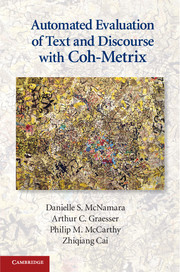Book contents
- Frontmatter
- Dedication
- Contents
- List of Figures
- List of Tables
- Acknowledgments
- Introduction
- Part I Coh-Metrix
- 1 What Is Text and Why Analyze It?
- 2 The Importance of Text Cohesion
- 3 The Science and Technology That Led to Coh-Metrix
- 4 Coh-Metrix Measures
- 5 Coh-Metrix Measures of Text Readability and Easability
- 6 Using Coh-Metrix Measures
- Part II A Beginner’s Guide to Writing Coh-Metrix Research
- Concluding Remarks
- References
- Appendix A Coh-Metrix 3.0 Indices
- Appendix B Coh-Metrix Indices Norms
- Index
5 - Coh-Metrix Measures of Text Readability and Easability
Published online by Cambridge University Press: 05 June 2014
- Frontmatter
- Dedication
- Contents
- List of Figures
- List of Tables
- Acknowledgments
- Introduction
- Part I Coh-Metrix
- 1 What Is Text and Why Analyze It?
- 2 The Importance of Text Cohesion
- 3 The Science and Technology That Led to Coh-Metrix
- 4 Coh-Metrix Measures
- 5 Coh-Metrix Measures of Text Readability and Easability
- 6 Using Coh-Metrix Measures
- Part II A Beginner’s Guide to Writing Coh-Metrix Research
- Concluding Remarks
- References
- Appendix A Coh-Metrix 3.0 Indices
- Appendix B Coh-Metrix Indices Norms
- Index
Summary
One important question with which the Coh-Metrix team has grappled is how to measure text difficulty, complexity, or, in turn, its ease. This chapter describes the two traditional readability measures provided by Coh-Metrix – Flesch–Kincaid Grade Level (RDFKGL) and Flesch Reading Ease (RDFRE) – as well as the readability index that we developed for second-language texts (RDL2). We also describe the Coh-Metrix Text Easability Principal Component Scores that are provided in Coh-Metrix 3.0 (i.e., PCNAR, PCSYN, PCCNC, PCREF, PCDC, PCVERB, PCONN, PCTEMP).
The traditional and more common approach to scaling texts is to have a single metric of text ease or difficulty. This is the approach taken by popular metrics such as Flesch–Kincaid Grade Level (Kincaid, Fishburne, Rogers, & Chissom, 1975) and Flesch Reading Ease (Flesch, 1948; Klare, 1974–1975), which are provided by the Coh-Metrix tool. These two Flesch–Kincaid metrics are based on the length of words and sentences within the text. In Coh-Metrix, the Flesch–Kincaid Grade Level (RDFKGL) is computed as [(0.39 * sentence length) + (11.8 * word length) – 15.59]. The Flesch Reading Ease (RDFRE) is computed as [206.835 – (1.015 * sentence length) – (84.6 * word length)]. Sentence length (DESSL) is measured by the mean number of words per sentence in a text, whereas word length (DESWLsy) is measured as the mean number of syllables per word (which is highly correlated with the mean number of letters).
- Type
- Chapter
- Information
- Publisher: Cambridge University PressPrint publication year: 2014
- 2
- Cited by



